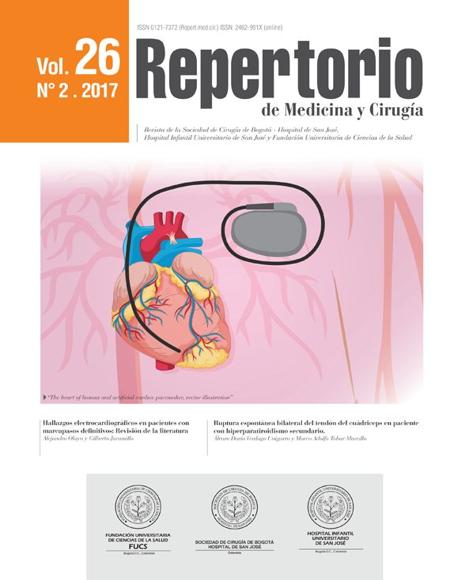Síndrome de Moebius: manifestaciones neurológicas, musculoesqueléticas y del lenguaje
Moebius syndrome: Neurological, musculoskeletal and speech anomalies
Esta obra está bajo una licencia internacional Creative Commons Atribución-NoComercial-CompartirIgual 4.0.
Mostrar biografía de los autores
El síndrome de Moebius es una enfermedad congénita caracterizada por parálisis facial no progresiva y alteración de la abducción ocular de uno o ambos ojos por compromiso del VI par, pudiendo extenderse a otros pares oculomotores, así como al IX, X y XII. Se ha asociado con manifestaciones musculoesqueléticas y epilepsia. Presentamos el caso de un preescolar con antecedente de intento fallido de la madre de interrupción voluntaria del embarazo en el primer trimestre. Al nacimiento se evidencia diplejía facial, parálisis bilateral del VI par y pie equino varo. A los 17 días de vida presenta crisis tónico-clónicas y se diagnostica síndrome de Moebius y epilepsia de difícil control. Durante el seguimiento presenta retardo global del desarrollo, con predominio en el área del lenguaje y alteración de la deglución.
Visitas del artículo 31017 | Visitas PDF 2789
Descargas
1. Picciolini O, Porro M, Cattaneo E, Castelletti S, Masera G, Mosca F, et al. Moebius syndrome: clinical features, diagnosis, management and early intervention. Ital J Pediatr. 2016;42:56.
2. MacKinnon S, Oystreck DT, Andrews C, Chan WM, Hunter DG, Engle EC. Diagnostic distinctions and genetic analysis of patients diagnosed with moebius syndrome. Ophthalmology. 2014;121:1461–8.
3. Puvabanditsin S, Garrow E, Augustin G, Titapiwatanakul R, Kuniyoshi KM. Poland-Möbius syndrome and cocaine abuse: a relook at vascular etiology. Pediatr Neurol. 2005;32:285–7.
4. Towfighi J, Marks K, Palmer E, Vannucci R. Möbius syndrome. Neuropathologic observations. Acta Neuropathol. 1979;48:11–7.
5. Bianchi B, Copelli C, Ferrari S, Ferri A, Sesenna E. Facial animation in patients with Moebius and Moebius-like syndromes. Int J Oral Maxillofac Surg. 2010;39:1066–73.
6. Uzumcu A, Karaman B, Toksoy G, Uyguner ZO, Candan S, Eris H, et al. Molecular genetic screening of MBS1 locus on chromosome 13 for microdeletions and exclusion of FGF9, GSH1 and CDX2 as causative genes in patients with Moebius syndrome. Eur J Med Genet. 2009;52:315–20.
7. Wu SQ, Man FY, Jiao YH, Xian JF, Wang YD, Wang ZC. Magnetic resonance imaging findings in sporadic Möbius syndrome. Chin Med J (Engl). 2013;126:2304–7. 8. Tomas-Roca L, Tsaalbi-Shtylik A, Jansen JG, Singh MK, Epstein JA, Altunoglu U, et al. De novo mutations in PLXND1 and REV3L cause Möbius syndrome. Nat Commun. 2015;6:7199.
9. Guedes ZC. Möbius syndrome: misoprostol use and speech and language characteristics. Int Arch Otorhinolaryngol. 2014;18:239–43.
10. Blanchard K, Winikoff B, Ellertson C. Use of misoprostol during pregnancy and Möbius’ syndrome in infants. N Engl J Med. 1998;339:1553–4.
11. Quantin L. Manifestaciones otorrinolaringológicas del síndrome de Moebius. Revista FASO. 2013;3:16-20.
12. McClure PBD, Katarincic J, Eberson C. Orthopedic manifestations of Mobius syndrome: Case series and survey study. Int J Pediatr. 2016;2016:1–6.
13. Borbolla Pertierra AM, Acevedo González P, Bosch Canto V, Ordaz Favila JC, Juárez Echenique JC. [Eye and systemic manifestations of Mobius syndrome]. An Pediatr (Barc). 2014;81:297–302.
14. Bogart KR, Matsumoto D. Living with Moebius syndrome: adjustment, social competence, and satisfaction with life. Cleft Palate Craniofac J. 2010;47:134–42.
15. Cruz-Martínez E, Escobar-Mendoza E, Santana-García F, Urrutia-Ruíz M, Barragán-Pérez E, Espinoza-Montero R, et al. Factores etiológicos relacionados al pronóstico de la epilepsia en niños con síndrome de Möebius. Bol Med Hosp Infant Mex. 2006;63:241–6.









